Duntocher
This article needs additional citations for verification. (June 2013) |
Duntocher
| |
|---|---|
 Main Street, Duntocher | |
| OS grid reference | NS490730 |
| Council area | |
| Lieutenancy area | |
| Country | Scotland |
| Sovereign state | United Kingdom |
| Post town | CLYDEBANK |
| Postcode district | G81 |
| Dialling code | 01389 |
| Police | Scotland |
| Fire | Scottish |
| Ambulance | Scottish |
| UK Parliament | |
| Scottish Parliament | |
Duntocher (Scottish Gaelic: Dùn Tòchair or Druim Tòchair) is a village in Dunbartonshire, Scotland.
Although it is a far older settlement and still considered a village in its own right, it is administratively part of nearby Clydebank along with the neighbouring village of Hardgate and is now part of the West Dunbartonshire local authority area. The village expanded due to housebuilding by Clydebank town council after the Second World War, and later by the Wimpey firm in the late 1960s and early 1970s on what had been green belt land.
At one time this was the most north westerly point on the Glasgow Corporation Transport tram system, trams operating from here via Hardgate to Clydebank, and at times, on to Partick depot.
Duntocher historically had several cotton and corn mills, driven by the Duntocher Burn which is the traditional boundary between Duntocher and neighbouring village Hardgate.
The Antonine Wall also runs through the village, and ancient Roman fortifications are still visible in the local Goldenhill Park.
Duntocher has a Roman Catholic church - St. Mary's, a United Presbyterian Church and a Church of Scotland - Duntocher Trinity. The village also has one Roman Catholic primary school - St Mary's and one non-denominational, Carleith Primary School.
The village has a main street (Dumbarton Road) which acts as the main focal point for village activity. The majority of the villages shops and pubs, the cafe and the local churches and village halls are located along or very close to a small stretch of this road
The village is at the southern edge of the Kilpatrick Hills.
History
Until 1649 the villages of Bowling, West Dunbartonshire, Duntocher, Hardgate, Milton and Old Kilpatrick were all part of Kilpatrick Parish, then for a further 240 or so years formed part of Old or West Kilpatrick Parish. In 1889 however, the formation of Dumbarton County Council saw the transfer of authority to that body where it remained until 1975 when the villages were finally split up. Bowling and Milton became part of the Dumbarton District Council area and Duntocher, along with Old Kilpatrick and Hardgate, was absorbed by Clydebank District.[1]
Industry around the village was aided by the nearness of the Duntocher Burn, a fast flowing waterway ideal for industrial purposes. Between 1808 and 1831 four large cotton mills were set up there leading to a significant population increase and subsequent improvements being instituted to road, canal and river transport links. The boom was relatively short lived however and the demise of the cotton industry towards the end of the 1800s left Duntocher the loser.[2]
Today all five of the villages form a bedroom community for commuters to Clydebank, Dumbarton and Glasgow.[3]
References
- ^ Hood, John (2004). Old Bowling, Duntocher, Hardgate, Milton and Old Kilpatrick. Catrine, Ayrshire: Stenlake Publishing. p. 3. ISBN 9781840333190.
- ^ Hood, John. ibid. p. 3.
- ^ Hood, John. ibid. p. 3.
